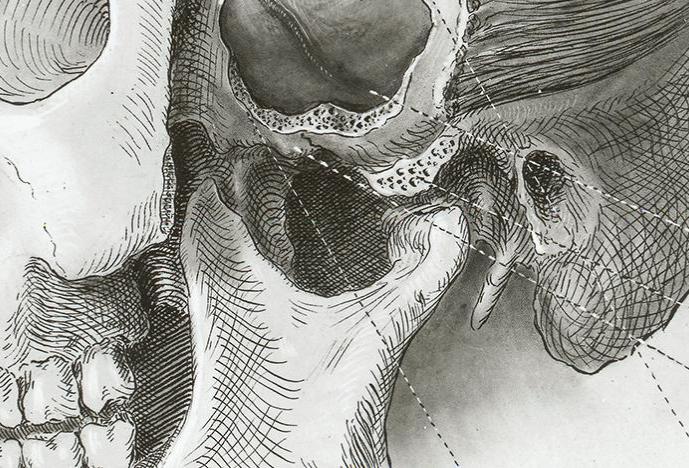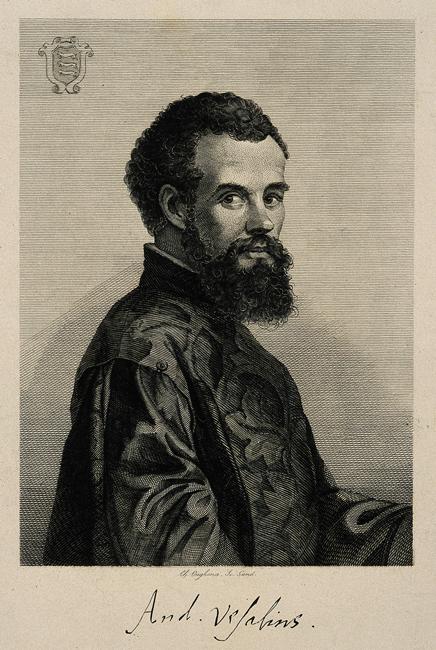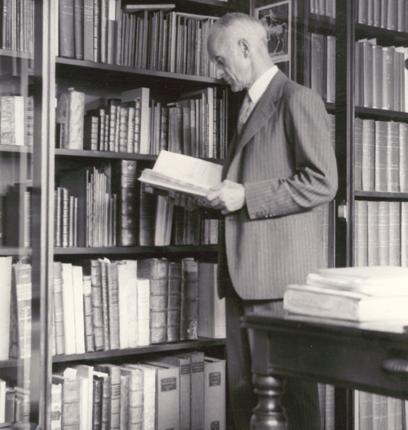Line Art
The work of Andreas Vesalius fascinated, and inspired, neurosurgeon Harvey Cushing
- 7 minute read

Detail from a line drawing of a human skull
It was to be an informal meeting, an invitation to have lunch, in fact, between the renowned neurosurgeon Harvey Cushing and Henry Viets, Class of 1916. The two were to meet in Cushing’s consulting room in what was then the Peter Bent Brigham Hospital.
In his brief reminiscence of Cushing published in 1969 in the Proceedings of the Massachusetts Historical Society, Viets, a neurologist and medical historian, describes his lunch companion on that day in 1915.
“The surgeon had just finished an operation. … Sitting on a high stool, he was writing up his long operative note, meticulously recording every detail and illustrating the more important procedures by clever sketches inserted at frequent intervals. These pen drawings, of considerable beauty, were designed to amplify his written descriptions in pictorial form. The writing of these notes was … always his first task after an operation was finished and never, under any circumstances, interrupted. So intent was he at his work that even my presence only evoked a welcoming nod. …”
Cushing, Class of 1895, was an avid collector of illustrated antiquarian medical books and a prolific author. He was also a talented artist whose lifelong hobby was to study the publications of Renaissance anatomist Andreas Vesalius. The influence that the detail and clarity of the woodcuts in Vesalian anatomical atlases had on Cushing is evident in his own commitment to preparing comprehensive, illustrated surgical notes.
At HMS, Cushing earned the first perfect grade ever given in pathology. According to certain biographers, Cushing was urged by teachers to skip further preliminary courses and focus on his work in the dissecting room, the best place for medical students to acquire hands-on knowledge of the human body. He began as a replacement house surgeon at Massachusetts General Hospital in April 1895, two months before graduation and before his formal appointment. At Mass General, he dissected amputated body parts whenever he could and performed his first full autopsies, sometimes begging grieving relatives for permission. So insistent was he that once, during a wake for a deceased patient, an irate widow screamed at him and demanded that he leave.
Rummage Sale
In 1896 Cushing took a position as assistant resident in surgery at Johns Hopkins Hospital. In Baltimore, Cushing and his wife, Katharine, lived next door to William Osler, who was himself accumulating a vast medical library. Osler often invited Cushing to inspect the latest leather-bound first editions Osler had purchased from European booksellers. Together they would pore over catalogs from British and continental book dealers and engage in animated discussions about rare books. Cushing recalled a memorable 1901 gathering at Osler’s house during which he and others had the opportunity to compare five copies of Vesalius’s De Humani Corporis Fabrica (1543). Cushing’s Life of Sir William Osler contains myriad references to rare medical books and to Vesalius’s work in particular.
Cushing acquired his first Vesalian treasure in 1903 when a colleague, after a year of studying abroad, lugged home an imperfect copy of the Fabrica that had been jumbled among books for sale in the back of a blacksmith’s shop in a side street in Rome. Cushing’s first purchase, a worn copy of what is commonly referred to as “The Paraphrasis,” the thesis Vesalius prepared for his bachelor of medicine degree at the University of Louvain, arrived in 1905 at a cost of 18 marks from a dealer in Berlin.
Postoperative Procedures
Cushing left Johns Hopkins in 1912 to become Moseley Professor of Surgery at HMS and surgeon in chief at Peter Bent Brigham Hospital; he brought with him his ingrained taste for rare books and medical illustration. His notes on his surgeries and dissections, which remain at Brigham and Women’s Hospital, are beautifully illustrated with heuristic drawings.
Although he was known for producing precise sketches of anatomy and his surgical procedures, Cushing employed professional illustrators for his published articles and books. One such illustrator, Mildred Codding, worked closely with him inside and outside the operating room between 1929 and 1932. In an interview in Surgical Neurology, Codding recalled that after operations Cushing routinely examined her sketches and drew over them to get the exact effect he wanted. The habit may well have been set by Cushing’s appreciation of Vesalius’s uncompromising devotion to direct observation of the human body and precise anatomical depiction.
Renaissance Man

Vesalius’s study of medicine at the University of Louvain was followed by additional training at the University of Paris. While in Paris, he attended, some might argue, endured, lectures by Galenists, who read texts to their pupils from a raised seat known as the cathedra while barbers on the floor below conducted perfunctory dissections, more often on animals than on human cadavers. The precepts of ancient thinkers such as Galen had The sixteenth-century anatomist Andreas Vesalius in an 1841 engraving.become so accepted by generations of scholastic commentators that their statements were widely considered infallible.
But Vesalius came of age when questioning tradition, whether ecclesiastical or scientific, was becoming acceptable. He sought bodies for dissection, at one point surreptitiously removing a criminal’s remains from a stake on a roadside near Louvain. Midnight expeditions to Paris’s Cemetery of the Innocents to dig for human bones sometimes flirted with disaster. In a story in the Epistle on the China Root, referenced in C. D. O’Malley’s Andreas Vesalius of Brussels, Vesalius describes how he and a fellow student once were “gravely imperiled ... by many savage dogs,” intent on the same bones. According to an anecdote in the Fabrica, Vesalius’s knowledge of anatomy was so deep that he won bets with his uncanny ability to identify any bone by touch, even when blindfolded.
Vesalius soon sought more advantageous opportunities for anatomical investigation in Italy. At age 22, he was appointed professor of surgery at Padua, then a great seat of medical learning. The position entailed teaching anatomy. At the height of his fame some 500 spectators were said to have crowded around him during his anatomical demonstrations; cadavers were elevated by ropes to afford the audience a better view.
Many of the dissections Vesalius conducted for his anatomical illustrations, however, were performed in his home. He was known to keep cadavers in his bedroom for several weeks for intensive study and to facilitate artistic renderings. He engaged Jan van Calcar, a former pupil of Titian, to make anatomical drawings under his direction. In Lives of the Most Excellent Painters, Sculptors, and Architects, the sixteenth-century historian and painter Giorgio Vasari refers to van Calcar as follows: “By his hand ... were the designs for anatomical studies which the most admirable Andrea Vessalio [sic] caused to be engraved and published with his words.”

Artistic Pursuits
Cushing’s interest in all things Vesalian took him far and wide. In 1909, with the permission of the curator of the Vesalianum at Basel, Cushing photographed a skeleton that Vesalius himself had prepared while waiting for proof sheets of the Fabrica. Cushing also was able to inspect the Fabrica’s original wood blocks, cut after van Calcar’s designs, at the University Library in Munich while on a visit to Europe. The wood blocks were destroyed years later during aerial bombardments in World War II.
Cushing retired from HMS in 1933 to join the faculty of Yale Medical School as professor of medicine in neurology. In his recollections of encounters with Cushing, Viets describes their last meeting in 1939 during a stopover in New Haven.
“He was alone in the house, and every table, chair, and settee was piled high with books about Vesalius, for he was hard at work writing his great bio-bibliography. He pushed a few of the books from one corner and made a seat. For once … I had to do all the talking. … He must have felt that this was our last meeting, and so it proved to be. …”
Cushing had experienced occasional chest pains throughout that summer but attributed them to ulcers. In early fall, he received word that Yale had found the funds and approved plans for a library to house his rare books and manuscripts. A few days later he felt serious and continuing pain after lifting a heavy Vesalian folio. He was taken to New Haven Hospital, where he died from the effects of a myocardial infarction.
A stickler for precision, Cushing remained faithful to Vesalian principles of investigation and depiction. The images incorporated in the works of Vesalius, he wrote, “spoke the universal language of art which requires no translation. …” Cushing’s Bio-bibliography, published posthumously, remains a landmark of bibliographical scholarship while his books on surgical techniques continue to be springboards for discussions of anatomy, pathology, or the physiology of the human body.
Jeffrey Mifflin is the archivist of the Massachusetts General Hospital.
Images: Yale University, Harvey Cushing /John Jay Whitney Medical Library (top and bottom images); Wellcome Library, Londo